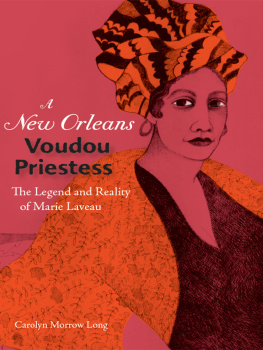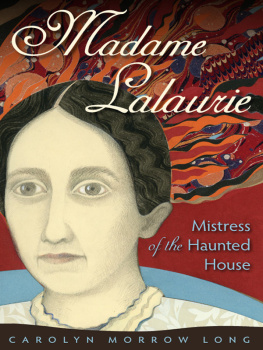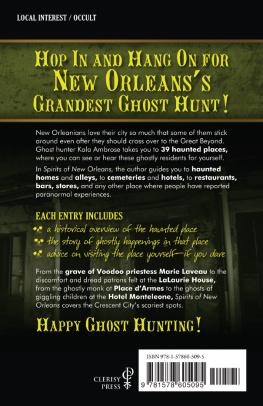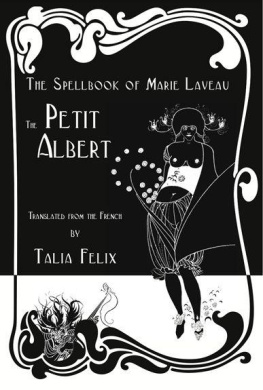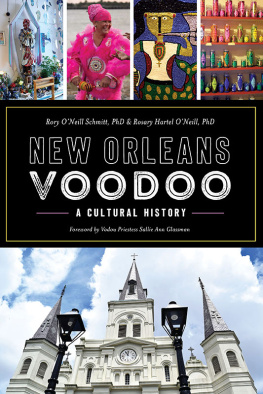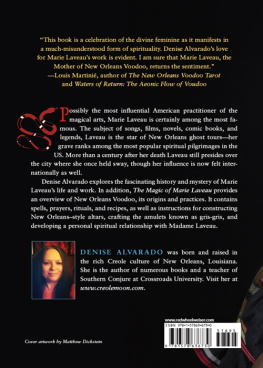A New Orleans Voudou Priestess
Florida A&M University, Tallahassee
Florida Atlantic University, Boca Raton
Florida Gulf Coast University, Ft. Myers
Florida International University, Miami
Florida State University, Tallahassee
University of Central Florida, Orlando
University of Florida, Gainesville
University of North Florida, Jacksonville
University of South Florida, Tampa
University of West Florida, Pensacola
A NEW ORLEANS
Voudou Priestess
The Legend and Reality of Marie Laveau
CAROLYN MORROW LONG
Copyright 2006 by Carolyn Morrow Long
Printed in the United States of America. This book is printed on Glatfelter Natures Book, a paper certified under the standards of the Forestry Stewardship Council (FSC). It is a recycled stock that contains 30 percent post-consumer waste and is acid-free.
All rights reserved
12 11 10 09 6 5 4 3 2
First cloth printing, 2006
First paperback printing, 2007
A record of cataloging-in-publication data is available from the Library of Congress.
ISBN 978-0-8130-2974-0 (cloth)
ISBN 978-0-8130-3214-6 (paper)
The University Press of Florida is the scholarly publishing agency for the State University System of Florida, comprising Florida A&M University, Florida Atlantic University, Florida Gulf Coast University, Florida International University, Florida State University, New College of Florida, University of Central Florida, University of Florida, University of North Florida, University of South Florida, and University of West Florida.
University Press of Florida
15 Northwest 15th Street
Gainesville, FL 32611-2079
www.upf.com

Atib-Legba, luvri bay pu mw, ago! Papa-Legba, luvri bay pu mw pu mw pasremove the barrier for me so that I may pass through. (Song for Papa Legba, guardian of the crossroads, opener of the way for all human endeavor, and keeper of the gate to the spirit world.)
I dedicate this book to the unacknowledged interviewers and researchers of the Louisiana Writers Project: Hazel Breaux, Edmund Burke, Catherine Dillon, Robert McKinney, Henriette Michinard, Zoe Posey, Jacques Villere, Maude Wallace, and Cecile Wright. Their work opened the way and removed the barrier for me.
Figures
Tables
Acknowledgments
A grant from the Office of Curatorial Affairs, National Museum of American History, Smithsonian Institution, enabled me to make the first of many extended research trips to New Orleans. After my retirement in 2001 the Museum allowed me to retain the position of Research Associate, giving me access to the collections and the Smithsonian Institution library system.
I was assisted in my work by many wonderful people. Mary Linn Wernet, archivist at the Cammie G. Henry Research Center, Northwestern State University Library in Natchitoches, Louisiana, provided hundreds of photocopies from the Louisiana Writers Project Collection. Dr. Charles Nolan, archivist of the Archdiocese of New Orleans, allowed me access to the sacramental registers, and Janet Adams, Connie Birabent, and Jack Belsom cheerfully hauled these heavy tomes out of the cold-storage vault. Sally Reeves and Ann Wakefield of the Notarial Archives Research Center, and Wayne Everard, Greg Osborn, and Irene Wainwright of the Louisiana Division, New Orleans Public Library, not only helped me find what I needed, but even answered my desperate long-distance requests for photocopies of documents and newspaper articles. Marie Windell, Louisiana and Special Collections, Earl K. Long Library, University of New Orleans, made photocopies of Louisiana Supreme Court documents. Mary Lou Eichorn and Pamela Arceneaux of the Historic New Orleans Collection Williams Research Center were of great assistance as was Dr. Wilbur Menary at Special Collections, Howard-Tilton Memorial Library, Tulane University. Dr. Alecia Long, historian, and Adrienne Berney, special projects curator, at the Louisiana State Museum, gave me valuable information on nineteenth-century domestic life, and Nathaniel Heller, assistant registrar, allowed me to spend a day searching the museums accession files. Liz Good and Jennifer Lushear, curators at the New Orleans Pharmacy Museum, provided information on epidemics.
New Orleans cemetery historian and preservationist Robert Florence, tour guide Mary Millan, and Laveau scholars Barbara Trevigne, Martha Ward, and Ina Fandrich added their expertise. Nancy Ochsenschlager allowed me to live in her home during my lengthy research trips. Paula Artal-Isbrand, Christine Barollier, and Nancy McKeon helped with translating long and complicated Spanish and French documents that were beyond my ability. Stephen Hank sent me a videotape of his film, The Widow Paris. Jazz historian Tad Jones guided me to the magical key to all nineteenth-century New Orleans business transactions, the Conveyance Office Index to Vendors and Purchasers. I especially appreciate the efforts of the volunteers of the USGenWeb Orleans Parish Archives Index Project, who have transcribed birth, marriage, and death records and city directories and made them available on the Web.
Dr. Judith Schafer, an expert on nineteenth-century civil law governing slavery, miscegenation, and inheritance, patiently answered my many questions. Judge Steve Ellis also provided information on Louisianas changing definitions of race. Dr. Virginia Gould, writer on the free woman of color Henriette Delille who founded the Sisters of the Holy Family, offered insights into the intricacies of nineteenth-century race relations. My friend Erin Loftus read the entire manuscript and made valuable suggestions. The critiques of Dr. David Estes and Dr. Vaughan Baker helped to improve the final product.
It was Meredith Morris-Babb, who, in her capacity as acquisitions editor at University of Tennessee Press, encouraged me to begin writing my first book, Spiritual Merchants, in 1995. Now, as director of the University Press of Florida, Meredith, editor-in-chief John Byram, and project editor Susan Albury have made the publication of A New Orleans Voudou Priestess as smooth as possible.
Finally, my utmost gratitude goes to my husband Douglas Wonderlic for his unfailing love and support, and for making it possible for me to quit my day job and devote my full attention to this project.
Introduction
My love affair with New Orleansand my obsession with Marie Laveaubegan in the spring of 1978. A Florida/Georgia native and longtime denizen of Alabama and Mississippi, I was living at the time in rural Vermont, terminally sick of the six-month winter and the dismal cold and slush of mud season. I escaped to New Orleans for a two-week visit and wanted to stay foreverI had never felt so at home. This Crescent City on the Mississippi River was the South and yet not the South, close to my roots and yet irrevocably foreign. People said yall and called me dawlin just like they did where I came from, but the similarity ended there. In New Orleans, there were fortune tellers and fire eaters at the cathedral; second-line parades and jazz funerals; nuns on the bus; John the Conqueror and Stop Evil Floor Wash in the grocery store; chicory coffee and

